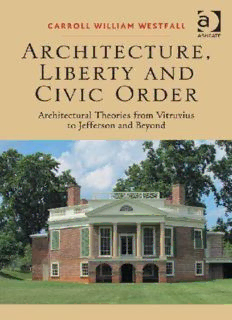
Architecture, Liberty and Civic Order: Architectural Theories from Vitruvius to Jefferson and Beyond PDF
Preview Architecture, Liberty and Civic Order: Architectural Theories from Vitruvius to Jefferson and Beyond
Architecture, Liberty And civic Order This page has been left blank intentionally Architecture, Liberty and civic Order Architectural theories from vitruvius to Jefferson and beyond carroll William Westfall University of Notre Dame, USA © carroll William Westfall 2015 All rights reserved. no part of this publication may be reproduced, stored in a retrieval system or transmitted in any form or by any means, electronic, mechanical, photocopying, recording or otherwise without the prior permission of the publisher. carroll William Westfall has asserted his right under the copyright, designs and Patents Act, 1988, to be identified as the author of this work. Published by Ashgate Publishing Limited Ashgate Publishing company Wey court east 110 cherry Street union road Suite 3-1 Farnham burlington, vt 05401-3818 Surrey, Gu9 7Pt uSA england www.ashgate.com British Library Cataloguing in Publication Data A catalogue record for this book is available from the british Library. Library of Congress Cataloging-in-Publication Data Westfall, carroll William. Architecture, liberty and civic order : architectural theories from vitruvius to Jefferson and beyond / by carroll William Westfall. pages cm includes bibliographical references and index. iSbn 978-1-4724-5653-3 (hardback : alk. paper)—iSbn 978-1-4724-5654-0 (ebook)— iSbn 978-1-4724-5655-7 (epub) 1. Architecture and history. 2. Architecture—Philosophy. i. title. nA2543.h55W47 2015 720.1—dc23 2015004202 iSbn: 9781472456533 (hbk) iSbn: 9781472456540 (ebk—PdF) iSbn: 9781472456557 (ebk—ePub) Printed in the united Kingdom by henry Ling Limited, at the dorset Press, dorchester, dt1 1hd Contents List of Figures vii Preface ix Acknowledgements xiii 1 Imitation in General 1 2 Vitruvius 13 3 Alberti on the Art of Building 25 4 Alberti, Architect and Urbanist 39 5 Vitruvianism and Palladio 61 6 Events in the Classical Tradition on the Continent 77 7 The Classical Tradition’s Fate West of the Channel 97 8 Jefferson, Architect, and the Classical Tradition 119 9 Imitation and Architecture’s Restoration 147 10 The Beautiful and Good City 167 Bibliography 183 Index 201 This page has been left blank intentionally List of Figures 1.1 Sir Banister Fletcher, “The Tree 6.1 Claude Perrault, The Five Orders of Architecture” 6.2 Gianbattista Piranesi, Carcere di 1.2 Columns, trees, and men as models inventione 14, c.1749/50–c.1761 of resistance to nature’s forces, at the University of Virginia 6.3 Claude-Nicolas Ledoux, Barrière de la Villette, Paris, 1788, by an unknown artist 4.1 Leon Battista Alberti, façade, Santa in 1810 Maria Novella, Florence, begun 1458 7.1 Roland Freart Sieur de Chambray, 4.2 View of Florence with a Chain, Palladio and Scamozzi, Ionic Order c.1480? c.1510? Woodcut, in the Staatliche Museen Pruessischer Kulturbesitz 8.1 Maison Carrée, Nîmes in Berlin 8.2 Thomas Jefferson, Capitol, Richmond, 5.1 Francesco di Giorgio Martini, “Man, 1786, engraving, c.1840 Church, and Proportions” 8.3 Richmond, Virginia, seen from the 5.2 Sebastiano Serlio, Temple of James River in 1817. Drawn by C. Fraser; Vesta, Tivoli printed by Hill 5.3 Sebastiano Serlio, Bramante’s Dome, 8.4 Thomas Jefferson, sketch plan for Basilica of Saint Peter national capital, made between March 10 and 21, 1791 5.4 Sebastiano Serlio, The Five Orders 8.5 Central section of Jefferson’s 1791 5.5 Giacomo Barozzi da Vignola, Doric at sketch superimposed on the Washington/ the Theater of Marcello L’Enfant scheme 5.6 Andrea Palladio, Villa Capra, 8.6 Thomas Jefferson, Poplar Forest, view la Rotonda of the site, 1806f viii ARCHITECTURE, LIBERTy AND CIVIC ORDER 8.7 Thomas Jefferson, Poplar Forest, from 9.2 Images of the seven building idea the garden, 1806f types: 1, tholos; 2, temple; 3, theater; 4, regia; 5, domus; 6, taberna; 7, hypostyle 8.8 Thomas Jefferson, University of Virginia, Charlottesville, 1817–25 9.1 Léon Krier, Civitas: res publica and res private; monuments without streets and squares, streets and squares without monuments Preface A civilization is said to be a large society, but we are not told clearly what kind of society it is. If we inquire how one can tell one civilization from another, we are informed that the most obvious and least misleading mark is the difference in artistic styles. This means that civilizations are societies which are characterized by something which is never in the focus of interest of large societies as such: societies do not go to war with one another on account of differences of artistic styles.1 This book is about the most important thing people make, which is the city. We build it to assist our pursuit of happiness, which each of us defines according to our own lights. To serve that pursuit the city must be a community that preserves and protects the liberty of each citizen. In a well-ordered and well-built city the good that its citizens seek is served by buildings whose beauty is the counterpart to the good. The good city and the beautiful building have a common source. It is nature, and imitating nature as it has been understood in the classical tradition has always connected the aspiration for the good and the beautiful. That is what the classic treatises on architecture teach. Their authors are few: Vitruvius, an ancient Roman, then Leon Battista Alberti and Andrea Palladio, the Renaissance architect–theorists who modernized Vitruvius, and finally Thomas Jefferson, the American Founder who left only snippets of theory. This narrative will review what they wrote supplemented by what they built and other ancillary material. This book will immerse architecture within the political life that it has served from antiquity down to the present when the civil order has come to preserve and protect liberty and justice. The narrative will stress the continuity within the classical, western tradition of the innovative changes that have made architecture the servant of liberty and present the resistance and threats to that service. A common thread will be the obvious truth that buildings, the cities they make, and the rural countryside express the purposes their builders expect them to serve.
